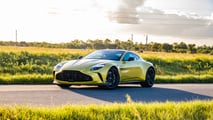
The name Aston Martin used to mean something more. It evoked James Bond and British excellence. Its iconic wings draped over the bonnets of some of the most beautiful cars on the planet—the DB5, the DB7, the DBS. But for the last decade or so, the brand has become more like a footnote in the market, as brands like Ferrari and Porsche have built cars that adhere closely to stronger brand identities, and often with impeccable performance credentials.
Under the recent leadership of Chairman Lawrence Stroll though, that's started to change for Aston. Stroll's company acquired 16.7 percent of Aston Martin in early 2020, before expanding that stake to 28.29 percent in 2022. Other investors, like Geely, Mercedes-Benz, and Saudi Arabia's Public Investment Fund have hopped on since, but Stroll still leads the charge as the company's chairman, with Adrian Hallmark—formerly of Bentley fame—taking over as the new CEO.
And in just a short time under Stroll, Aston has had success.

Take the DB12. While Astons under the previous administration were partially cobbled together with Mercedes pieces—and felt like it—the DB12 felt like the first complete product from top to bottom when it debuted in 2023.
It was the first Aston to bear the company’s new logo—a big deal for a brand so steeped in tradition. But most importantly, it was the first car to ditch the outdated Mercedes infotainment system for Aston's new ground-up interface. One of the brand's biggest problems of the past decade.
We've since seen a new Vanquish, which keeps the brand's iconic V-12 alive. There's a new Valhalla that—on paper, at least—sounds like a proper hypercar. And much-needed updates to the DBX, like the fresh infotainment system and the now-standard 697-horsepower powertrain, which could hopefully help solve the SUV's recent sales slump.
That's not to say it's all been smooth sailing under Stroll thus far.

"Supplier readiness" issues surrounding that shiny new infotainment system created production woes, ultimately forcing the company to slash its annual projection by roughly 1,000 units. And as of November, Aston was reportedly burning through $1.8 million per day due, in part, to dwindling demand in China and lackluster sales of the DBX.
But there's reason to be hopeful for Aston Martin in terms of re-solidifying the brand as a serious contender. Much of it falls on the shoulders of one vehicle: the Vantage.

No, it will never be as big of a seller as the DBX or as lauded as the Vanquish, but the Vantage represents the entry point into the Aston brand. As such, the Vantage is the first thing potential new customers will see when they walk into a showroom—the shiny beacon of hope plastered in the front window of every dealership from New York to Los Angeles. This car, Aston hopes, will get you out of that Ferrari Roma or Porsche 911 Turbo. No easy task.
But the Vantage has all the right pieces. Aston's recent string of designs—from the Vanquish to the Valhalla—have all been hugely successful. The Vantage is no exception. For my money, this car is prettier than any Porsche and sharper-looking than a C8 Z06. Ferrari might still have a bit of an edge, but the Vantage has perfect proportions, streamlined edges, and an excellent stance. When you look up the phrase “sports car” in the dictionary, it should look something like this:
That carries over to the interior. Long gone is any semblance of old Mercedes. Instead, there's a beautiful center stack surrounding a crisp 10.3-inch touchscreen display complete with wireless Apple CarPlay—finally. Everything within reach feels premium; The dials are knurled and heavy, the buttons set into place with a satisfying click, and there's even a tiny swathe of leather that runs atop the shift knob—just for an extra bit of premium feel every time you set off.


Plop into the perfectly shaped driver's seat and, as tight as the cabin may be, it feels like a proper cockpit. The seating position is low and driver-focused, and with a bit of tinkering, it's easy to position yourself in such a way that the steering wheel and pedals are perfectly aligned with your body shape, no matter how lanky.
There is still some Mercedes carryover—though, this one can stay. The engine.
The Vantage packs a powerful twin-turbocharged 4.0-liter V-8 hand-built in Germany by one of Mercedes-AMG's talented techs. Thanks to bigger turbochargers and larger cams here, the engine makes 656 horsepower and 590 pound-feet of torque, sending the Vantage from zero to 60 miles per hour in 3.5 seconds and on to a top speed of 195.

The Vantage is the first thing potential new customers will see when they walk into a showroom—the shiny beacon of hope plastered in the front window of every dealership from New York to Los Angeles.
And boy, this bugger is quick; It leaps off the line with a ferocious V-8 soundtrack flowing out of its quad exhaust tips. Sixty happens before you know it, and soon enough, you're well past traditional speed limits on the way to six figures. You'll experience a similar sensation in a well-optioned 911 for Ferrari Roma, otherwise, I can't think of many cars that accelerate quite like this.
Aston engineers improved the Vantage's front rigidity by 100 percent over its predecessor and boosted the back-end rigidity by 29 percent. It's stiff; The 21-inch wheels, pretty as they look, don't help soften the blow. But the Vantage isn't so uncomfortable over broken pavement that you couldn't drive it daily.
The way this car moves makes all that added stiffness worth it, though. To borrow an overused cliche: Just point and shoot. The Vantage's gaping maw goes exactly where you want it with a quick flick of the steering wheel. The steering is heavy—but not so heavy that it feels artificially weighted. You can feel the rubber from the Michelin Pilot Sport S 5 tires grinding over the pavement at every rotation. And the chassis has a perfect 50/50 weight distribution.


There's a bevy of clever tech here, too, like a nine-stage traction control system that you can tweak to your liking (though, frankly, the factory setting is perfectly fine). The electronic limited-slip differential goes from fully open to completely locked in 135 milliseconds. And adaptive dampers adorn each corner of the car—though, they mostly adapt from “stiff” to “much stiffer.”
That's all to say: The Aston Martin Vantage is a phenomenally good performance car.
We’ve waxed plenty poetic about the Vantage in the past, dubbing it “exactly what Aston Martin needs” and telling Porsche owners to “reconsider.” It even earned a spot as one of six performance cars in our inaugural Cool Car Cup, in which it absolutely shined among the likes of the Lamborghini Revuelto, Lotus Emira, and other excellent performance cars.

That's all to say: The Aston Martin Vantage is a phenomenally good performance car.
Much like the larger DB12, the latest Vantage is a fully realized sports car from top to bottom. It has all the performance, technology, and looks customers in this class have craved from the brand for damn near a decade. And at $191,000 to start—it’s expensive, but still priced competitively with the alternatives from Ferrari, Lamborghini, Porsche, and others.
This is the car that could save Aston Martin from another decade of irrelevancy. Let’s hope it does.














